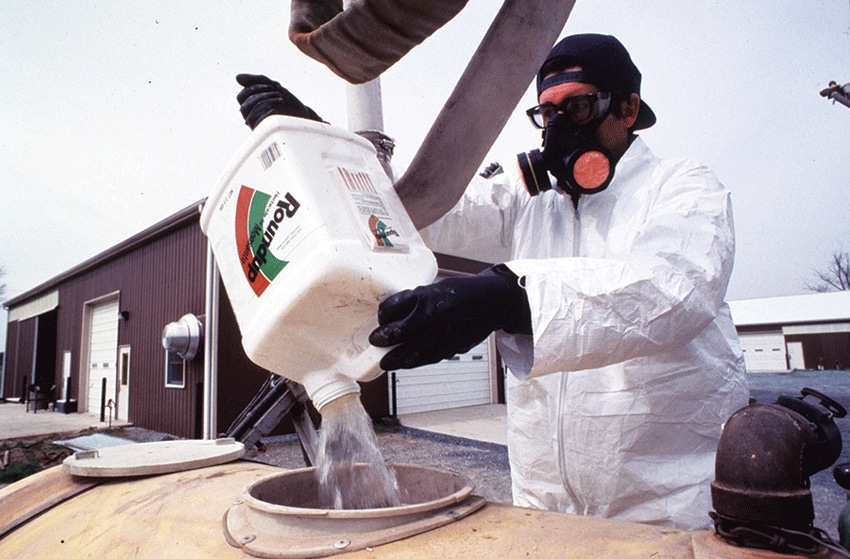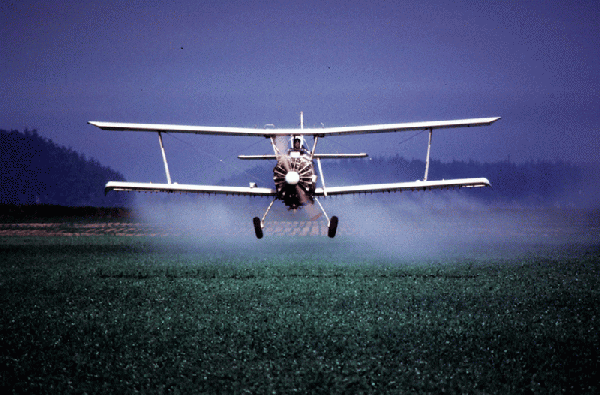
Changes in the federal Worker Protection Standard will have an impact on pesticide workers and handlers beginning January 2017, and those affected need to become familiar with the rules and make preparations for compliance, says Jasper Cobb, branch director of pesticide compliance and enforcement for the Mississippi Department of Agriculture and Commerce Pesticide Compliance and Enforcement Division.
The changes to the rule by the Environmental Protection Agency “cover a lot more than previously, with a lot more people covered,” he said at the annual meeting of the Mississippi Agricultural Consultants Association at Mississippi State University.

Allen McKnight, from left, Delta Agricultural Consulting, Greenville, Miss.; James Simpson, Simpson Ag Services, Macon, Miss.; and Charlie Craig, Friars Point, Miss., were among those attending the annual meeting of the Mississippi Agricultural Consultants Association.
“The Worker Protection Standard includes provisions to reduce the risk of illness or injury to pesticide workers or handlers who have occupational exposure to pesticides applied to crops or in agricultural establishments,” he said. “As a result of the rule changes, there is a lot more liability than previously, and we want to get information out to those in the agricultural community who will be affected so they can learn the changes and be prepared when the new rule goes into effect.”
Most of the changes will become effective January 2017, Cobb says, but the requirements for training won’t be effective until January 2018. “We expect during 2016 there will continue to be changes in definitions and interpretations as the EPA gets questions from Departments of Agriculture in the various states, farm organizations, and other stakeholders.”
The original Worker Protection Standard was published in 1992 and was fully implemented in 1995.
In the Federal Register notice, the EPA says “this final rule will enhance protections provided to agricultural workers, pesticide handlers, and other persons under the WPS by strengthening elements of the existing regulation, such as training, notification, pesticide safety and hazard communication information, use of personal protective equipment, and the providing of supplies for routine washing and emergency decontamination.
“EPA expects this final rule to prevent unreasonable adverse effects from exposure to pesticides among agricultural workers and pesticide handlers, child farm workers and farm worker families, and other persons who may be on or near agricultural establishments, to to mitigate exposures that do occur.”
Cost estimates for compliance
The notice says the rule “primarily seeks to protect workers (those who perform hand labor tasks in pesticide-treated crops, such as harvesting, thinning, and pruning) and handlers (those who mix, load, and apply pesticides).” The rule doesn’t cover persons working with livestock.

Calvin Bowlin, left, Pioneer, Carrollton, Miss., and James Oliver, Oliver AgriEnterprises/Raymat Crop Science, Inc., Hernando, Miss., were discussing the outlook for the 2016 crop season.
The EPA estimates the incremental cost of the WPS to be between $60.2 and $66.9 million per year, using a 3 percent discount rate, or $53 million to $62.2 million per year using a 7 percent discount rate.
“The majority of the costs…are borne by the farms, nurseries, and greenhouses that hire labor and use pesticides, which account for about 20 percent of all farms producing crops in the U.S.” Family owned farms that use pesticides but don’t hire labor “may collectively bear costs of about $1.4 million per year.” Total costs related to the revisions, the EPA says, “amount to an average expenditure of about $30 per year per farm worker.”
Benefits, in terms of reduced illness from exposure to pesticides, are likely to exceed $64 million per year in terms of avoided costs associated with occupational pesticide incidents and with reductions inchronic diseases associated with occupational pesticide exposure, although the amount the EPA can quantify is much less.
The estimated quantified benefits from reducing acute worker and handler exposure to pesticides total between $0.6 million and $2.6 million annually, the EPA notice says.
Those who will be affected
Those affected by the rule, Jasper Cobb told the Mississippi consultants, include any person, other than an agricultural employer, who employs any handler to perform handler activities on an agricultural establishment. A handler is defined as “any person, including a self-employed person, who is employed by an agricultural employer or commercial pesticide handler employer and performs any of the following activities”:
• Performing tasks as a crop advisor during any pesticide application or re-entry interval, or before the inhalation exposure level listed in the pesticide product labeling has been reached. A crop advisor is defined as “any person who is assessing pest numbers, damage, pesticide distribution, or the status or requirements of agricultural plants.
• Commercial pesticide handling establishments: “Any enterprise, other than an agricultural establishment, that provides pesticide handler or crop advising services to agricultural establishments.
Duties of commercial pesticide handler employees include:
• Insuring that each handler employed receives the protections required by the Worker Protection Standard.
• Insuring that any handler employed is at least 18 years old.
• Providing to each person who supervises any handlers the information and directions sufficient to insure that each handler receives the protections required by the WPS.
• Insuring that whenever a handler will be on an agricultural establishment (farm), the handler is provided information about, or is aware of, the specific location and description of any treated areas where a re-entry interval is in effect, and the restrictions on entering those areas.
Training requirements/exemptions
Before any handler performs any handler activity involving a pesticide product, the handler employer must insure that the handler has been trained in accordance with the WPS within the last 12 months. Exceptions are for “a handler who is currently certified as an applicator of restricted use pesticides, or a handler who is certified or licensed as a crop advisor by a program acknowledged as appropriate, in writing, by the EPA or the state agency responsible for pesticide enforcement.”
Training topics include the need for and appropriate use and removal of all personal PPE; how to recognize, prevent, and provide first aid treatment for heat-related illness; the responsibility of handler employers to provide handlers with information and protections designed to reduce work-related exposures and illnesses; the requirement that handlers must be at least 18 years old; and the responsibility of handler employers to insure that handlers have received respirator fit-testing, training, and medical evaluation if they are required to wear a respirator by the product labeling.
IT’S FREE! Stay informed on what’s happening in Mid-South agriculture: Subscribe to Delta Farm Press Daily.
Any person who performs handler activities involving a pesticide product must use the clothing and personal protective equipment specified on the pesticide labeling for the use of the product. The handler employer must provide to the handler the personal protective equipment required by the pesticide product labeling, and must insure that the personal protective equipment is clean and in proper operating condition.
There is an exemption for the licensed crop advisor, who “may make their own determination of the appropriate personal protective equipment for entry into a treated area during a re-entry interval, and may substitute their self-determined set of personal protective equipment, provided the application is complete and the crop advisor is certified or licensed by the EPA or a state approved program; the certification or licensing program requires pesticide safety training that includes all the information in the WPS rule; and the crop advisor who enters a treated area during a re-entry interval only performs crop advising tasks while in the treated area.”
Check current commodity prices
Crop advisors and their employees entering treated areas to perform crop advising tasks while a re-entry interval is in effect may substitute either of the following sets of personal protective equipment for the label-required personal protective equipment for handler activities: “The PPE specified on the pesticide product labeling for early entry, or coveralls, shoes plus socks, and chemical-resistant gloves made of any waterproof material, and eye protection if the pesticide product labeling requires protective eyewear for handlers.”
“This rule is very extensive,” Cobb says, “and those affected by it need to be aware of the changes.” It can be accessed in the Federal Register. The link is here.
2015 Mississippi spray drift incidents
Cobb reported on spray drift incidents for 2015 and exemptions being sought for agricultural chemicals for 2016.

There were 66 spray drift incidents investigated in Mississippi during 2015.—Getty Images/USDA
“We had 66 investigations of spray drift in the past year,” he says. “Of those, 21 involved aerial application, 26 ground, and 19 unknown. Glyphosate drift totaled 38 cases; there were 8 cases involving Gramoxone; 6 for dicamba and 2,4-D; and 14 other/unknown.”
There were 23 cases involving yard/garden, 13 rice, 11 wheat, 7 grain sorghum, timber and soybeans 4 each, corn and cotton 1 each, and 2 involving vehicles.
The department will resubmit a request for a Section 18 exemption for Transform for control of sugarcane aphids in grain sorghum and plant bugs in cotton, Cobb says.
“We were putting together a Section 3 request for anthraquinone, but while we were in the process a Section 3 label was approved for blackbird damage in water-seeded and dry-seeded rice. We also will submit a request for use of fipronil for control of ‘crazy ants’ in Mississippi coastal counties.”
About the Author(s)
You May Also Like




